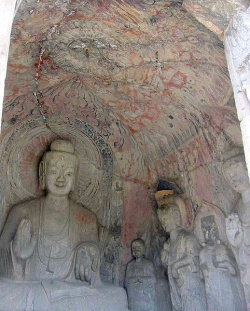Difference between revisions of "Middle Binyang Cave"
| Line 1: | Line 1: | ||
[[File:Longmen-binyang-middle-cave-wideshot.jpg|thumb|250px|]] | [[File:Longmen-binyang-middle-cave-wideshot.jpg|thumb|250px|]] | ||
| − | '''Middle Binyang | + | |
| + | |||
| + | '''[[Middle Binyang Cave]]''' (simplified {{Wiki|Chinese}}: [[宾阳中洞]]; {{Wiki|traditional Chinese}}: [[賓陽中洞]]; pinyin: [[Bīnyáng Zhōng Dòng]]) is {{Wiki|cave}} number 140 at the [[Longmen Grottoes]] near [[Luoyang]], {{Wiki|Henan}}, [[China]] | ||
==Dimensions== | ==Dimensions== | ||
| Line 8: | Line 10: | ||
==History== | ==History== | ||
| − | [[Constructed]] by order of [[Wikipedia:Emperor Xuanwu of Northern Wei|Emperor Xuanwu]] of the {{Wiki|Northern Wei}} in honour of his [[parents]] [[Wikipedia:Emperor Xiaowen of Northern Wei|Emperor Xiaowen]] and [[Empress]] [[Wenzhao]], the {{Wiki|cave}} was supposed to imitate Lingyansi | + | [[Constructed]] by order of [[Wikipedia:Emperor Xuanwu of Northern Wei|Emperor Xuanwu]] of the {{Wiki|Northern Wei}} in honour of his [[parents]] [[Wikipedia:Emperor Xiaowen of Northern Wei|Emperor Xiaowen]] and [[Empress]] [[Wenzhao]], the {{Wiki|cave}} was supposed to imitate [[Lingyansi Cave]] at the [[Yungang Caves]]. |
| + | |||
| + | Work began in 500 and was completed in 523. In 1987 a brick-entrance was demolished to reveal two new figures: a four-headed, four-armed [[Brahma]] and a one headed, four armed [[Śakra]] [[devendra]]. | ||
| + | |||
==Features== | ==Features== | ||
| − | The back wall is a carved [[Sakyamuni]], with two discliples and two [[bodhisattvas]]. The main [[Buddha]] and [[bodhisattvas]] are representative of the {{Wiki|Northern Wei}} sculptural style. A [[lotus-flower]] pool decorates the floor. The ceiling is engraved with a blossoming [[lotus flower]], 8 musical [[apsarases]], 2 attending [[apsarases]] and tassel and drapery patterns. The front wall is covered with a large [[Vimalakirti]] relief, the [[Prince Sattva]] [[jataka]], the {{Wiki|Prince}} [[Sudatta]] [[jataka]], an emperor/empress worshipping scene and ten [[deity]] [[kings]]. | + | |
| + | The back wall is a carved [[Sakyamuni]], with two discliples and two [[bodhisattvas]]. | ||
| + | |||
| + | The main [[Buddha]] and [[bodhisattvas]] are representative of the {{Wiki|Northern Wei}} sculptural style. | ||
| + | |||
| + | A [[lotus-flower]] pool decorates the floor. The ceiling is engraved with a blossoming [[lotus flower]], 8 musical [[apsarases]], 2 attending [[apsarases]] and tassel and drapery patterns. | ||
| + | |||
| + | The front wall is covered with a large [[Vimalakirti]] relief, the [[Prince Sattva]] [[jataka]], the {{Wiki|Prince}} [[Sudatta]] [[jataka]], an [[emperor]]/[[empress]] worshipping scene and ten [[deity]] [[kings]]. | ||
| + | |||
==Nearby [[caves]]== | ==Nearby [[caves]]== | ||
| − | The {{Wiki|cave}} is flanked by [[North]] and [[South | + | |
| + | The {{Wiki|cave}} is flanked by [[North]] and [[South Binyang Caves]]. | ||
{{W}} | {{W}} | ||
[[Category:Buddhist Caves]] | [[Category:Buddhist Caves]] | ||
Latest revision as of 04:39, 12 February 2016
Middle Binyang Cave (simplified Chinese: 宾阳中洞; traditional Chinese: 賓陽中洞; pinyin: Bīnyáng Zhōng Dòng) is cave number 140 at the Longmen Grottoes near Luoyang, Henan, China
Dimensions
12m long, 10.9m wide, 9.3m high.
History
Constructed by order of Emperor Xuanwu of the Northern Wei in honour of his parents Emperor Xiaowen and Empress Wenzhao, the cave was supposed to imitate Lingyansi Cave at the Yungang Caves.
Work began in 500 and was completed in 523. In 1987 a brick-entrance was demolished to reveal two new figures: a four-headed, four-armed Brahma and a one headed, four armed Śakra devendra.
Features
The back wall is a carved Sakyamuni, with two discliples and two bodhisattvas.
The main Buddha and bodhisattvas are representative of the Northern Wei sculptural style.
A lotus-flower pool decorates the floor. The ceiling is engraved with a blossoming lotus flower, 8 musical apsarases, 2 attending apsarases and tassel and drapery patterns.
The front wall is covered with a large Vimalakirti relief, the Prince Sattva jataka, the Prince Sudatta jataka, an emperor/empress worshipping scene and ten deity kings.
Nearby caves
The cave is flanked by North and South Binyang Caves.
